MSI GE40 Review: a Slim Gaming Notebook
by Jarred Walton on July 16, 2013 3:00 AM ESTGreat Battery Life, LCD Sadness, Temperatures, and Noise
We wrap up our performance evaluation with a look at battery life and LCD quality, along with temperatures and noise. Here we get one winner and a few losers. It’s really unfortunate, as a better LCD could have warranted a reward of some form. We’ll start with the good news first, though: battery life is quite excellent, all told. Our Light, Medium, and Heavy battery life tests range from surfing the Internet to intense browsing while listening to music, with the Heavy test adding in a constant 1MBps download via local FTP with intense web surfing and 12Mbps 1080p H.264 playback. Gaming off the mains will be even more demanding, but otherwise the results below should represent a typical result as well as worst-case. The LCD was set for ~200 nits, which on the MSI GE40 ended up being 80% (two steps down).
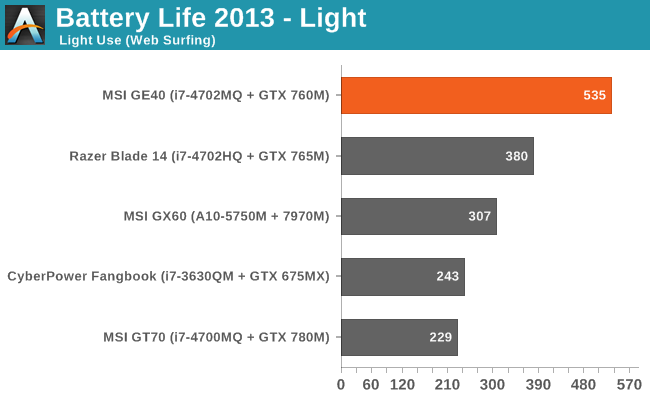
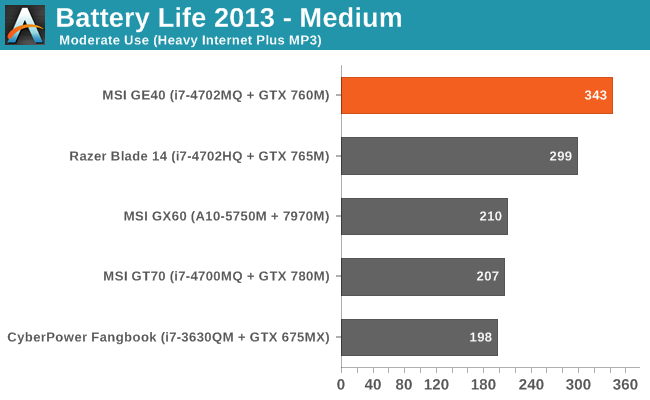
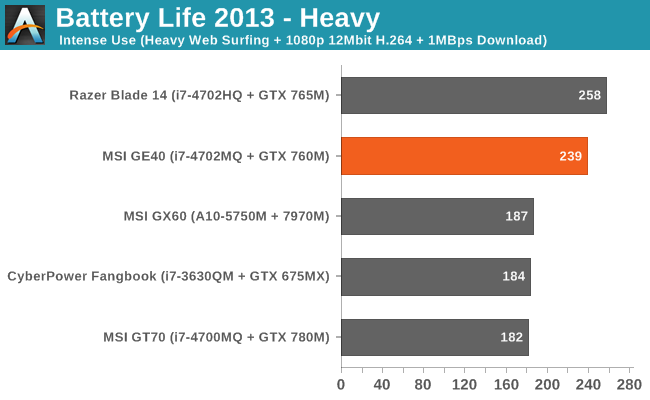

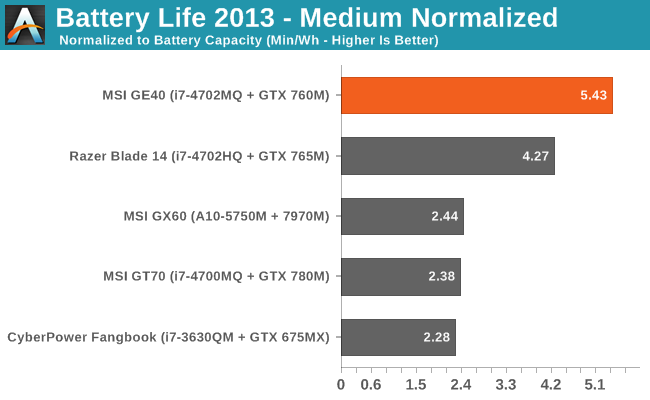
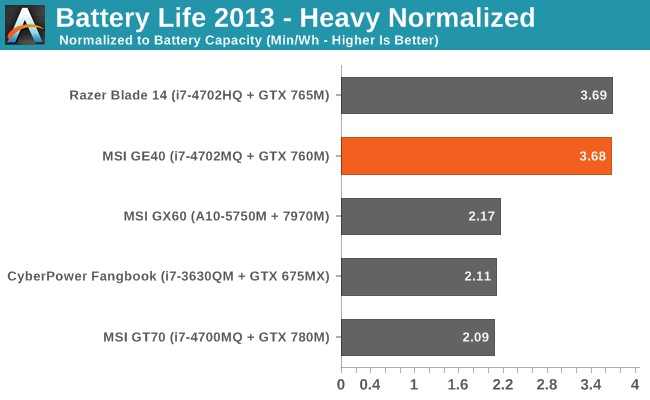
Haswell is a mobile-focused architecture, and it shows. It may not be much faster than Ivy Bridge in many cases, but seeing a viable gaming notebook pull off nearly nine hours of useful battery life is quite impressive. That drops quickly as you put a heavier load on the GE40, with around 5.75 hours of moderately heavy use and four hours of heavy use possible. If you just want to watch 1080p H.264 video, you can expect closer to five hours of battery life. Normalized battery life ends up equaling the Razer Blade in our heavy test while soundly trouncing all contenders in the light and medium tests.
But what about gaming on battery power? I ran a test as requested in the comments, and the results aren't particularly promising. First, battery life while gaming (running Skyrim) ended up at 104 minutes, still well short of the two hour mark. What's potentially worse is that even with all the settings tweaked for higher performance, NVIDIA's drivers (or MSI's BIOS/firmware) throttle GPU performance while on battery power. Plugged in Skyrim was running at a steady 60-70FPS, but once the power cord was unplugged it dropped down to 30-32FPS (with some dips into the low 20s on occasion). It looks like the notebook is shooting for 30FPS and no more when on battery power; I'll see if I can coax any better performance out of it in the morning, but even in the reduced performance mode you're still not going to be gaming for long while unplugged.
“What good were eyes to me? Nothing I could see could bring me joy.”
Perhaps that’s a bit too strong, but if you take the poor LCD from the Razer Blade 14 review and then limit the maximum brightness to 250 nits instead of 450 nits, you have the GE40’s LCD. Viewing angles are as bad as you’ll ever get with TN panels, and while it’s still possible to play games and not feel too bad, any photo editing is best done elsewhere. Here are the numbers:
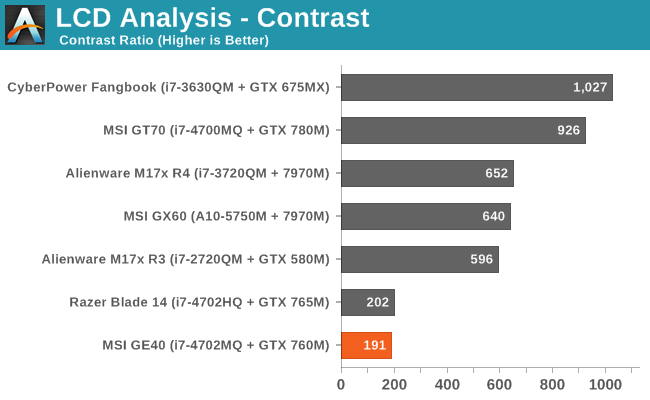
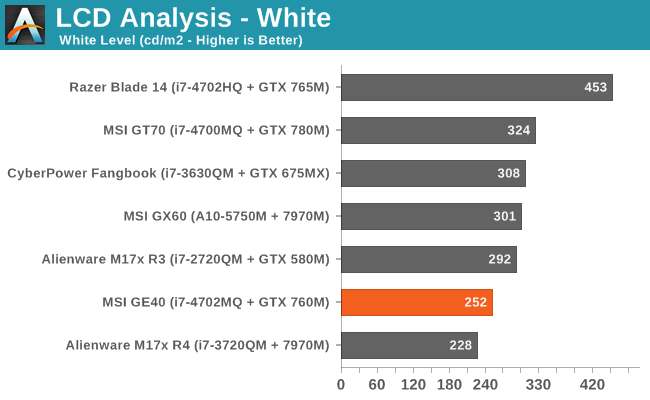
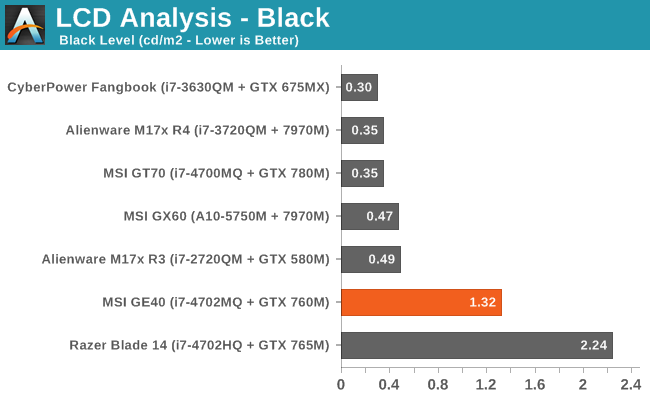
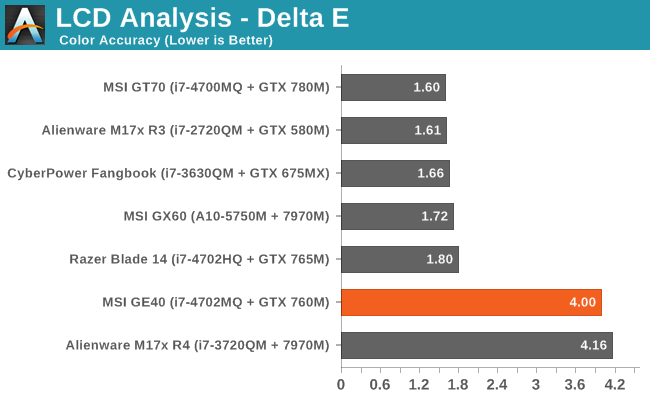

A contrast ratio below 200:1 is simply unacceptable in today’s market. This is the sort of display that will continue to drive users over to tablets. I do worry that something has gone wrong with my i1 Display2 colorimeter, as the DeltaE on the GE40 and M17x R4 are both much higher than I’d expect, so take those figures with a grain of salt until I can confirm my colorimeter is still working, but even if it’s off by a factor of two there’s nothing good to say. Average color accuracy without calibration is far worse, of course: I measured 17.4 average dE with the best result being 8.4 and the worst being 25.5—basically the same as what you see with many Android tablets I guess. Color gamut is also low, but really the contrast needs to be improved before we even worry about color gamut or accuracy.
Too Hot to Handle?
I ran some extended stress testing of the GE40, just to see what might happen. Under a full load, it took about ten minutes before the CPU and GPU had reached more or less equilibrium. It’s a bit warm here in WA right now, and I don’t have AC, so ambient temperatures were around 80-85F (27-29C), but even so the maximum CPU temperature of 98C is a concern. The GTX 760M didn’t have as much trouble, maxing out at a still-toasty-but-not-horrible 80C.
In practice, these figures aren’t even unusual; an extended session of Metro: Last Light looping our Value settings at 1600x900 hit 98C/84C on the CPU/GPU (average temps of 95.5C/81.4C), so the GPU actually got a bit hotter when the CPU wasn’t fully loaded. Idle temperatures at least are good, sitting around 46C/34C, and the surfaces of the GE40 for the most part are not too hot—one of the benefits of using plastic on the bottom of the chassis. The only real hot spot is on the left hand side near the exhaust, as you would expect. Still, the cooling is definitely pushing the limits of what we would deem “acceptable”—a year or two down the road when the cooling fins have a fine layer of dust and grime on them and we could easily be talking about an overheating notebook.
It’s Also Relatively Noisy
We haven’t had a lot of time with Haswell so far, so it’s difficult to say whether the temperatures in the upper 90s that we’re seeing under sustained load are normal or problematic. It’s very hard to get good thermals, high performance, and low noise levels in the same package, particularly if that package is less than an inch thick like the GE40. We’ve seen that thermals are definitely pushing the limit of what we’re comfortable with, but noise isn’t all that great either. At idle, we measured noise levels of 34.7dB while pretty much any reasonable gaming workload increased that to a maximum of 44.4dB; even under light loads (e.g. surfing the web), the fan will often spin up a bit to the 37dB range. Our full-load stress testing didn’t increase the noise, and even covering the exhaust with my hand didn’t create any additional noise (though that was mighty hot!), so the fan is basically topped out when gaming.










93 Comments
View All Comments
alex_l17 - Thursday, July 18, 2013 - link
actually... if you are just doing some upgrade of the RAM, MSI will still honor the warranty.. i had experience of that before. I called and spoke to the tech support, and they replied saying the RAM upgrade doesn't void warranty.xenol - Tuesday, July 16, 2013 - link
What's starting to annoy me is still, a lot of these laptops that aren't ultrabooks and whatnot, come with a VGA port. I mean, sure, a lot of external displays can take it, but it just feels very out of place. Throw in a Mini-DP and another USB port!airmantharp - Tuesday, July 16, 2013 - link
Projectors. It's sad, but it's a real limitation everywhere.JarredWalton - Tuesday, July 16, 2013 - link
Yup. There are a ton of projectors out there that pre-date HDMI and DP. It would definitely be nice to be able to run three digital displays off of a laptop, but most companies are so busy cutting corners that it's not even a minor consideration.Engineering: "For $5 extra, we can add two more digital video ouputs."
Management: "What!? Forget that -- we can save $0.05 by using 100Mbit Ethernet instead of Gigabit Ethernet. That's what we need to do! And while we're at it, find a cheaper LCD -- there's no sense spending $75 for a display that most people won't notice! All they care about are mega-whatevers and giga-things, and we need to give them lots of those. Screw abstract ideas like build quality and color accuracy...."
Bob Todd - Wednesday, July 17, 2013 - link
Hahaha...you brought up one of the things that drives me bonkers. There's no excuse for 100Mbit Ethernet STILL showing up in so many laptops. The BOM difference has to be almost non-existent these days, and yet we still see machines north of $500 only offering 100Mbit. I've seen so many machines in the past year that look kind of interesting as low cost general compute devices, then I scroll down and see "Fast Ethernet". It's like a cruel joke.Lacrimosa - Wednesday, July 17, 2013 - link
We have exactly opposing sources for annoyance :-) I am looking for these kinds of machines because I want something that I can take with me on business trips: powerful enough to game on when in hotels on evenings and good for doing my work when on client premises. I need to hold a lot of presentations so connectivity to projectors and external screens is important. Some of my collegues use these dongles to connect HDMI or some other port to those VGAs that are everywhere, but often those dongles are lost, or broken, or twist so that suddenly picture disappears... not good. I have had to pass on quite a few machines because they do not have VGA port anymore (for example that Razer Blade does not have one).yhselp - Tuesday, July 16, 2013 - link
Alright, great review in general - helpful, objective and well-written and I really mean all that. Thank you for that.However, every once in a while I come across a comment or conclusion in one of the articles I read which makes me go - whaaat?! Why did they (this is not aimed directly at Mr. Walton) write this...
I don't mean to be disrespectful, but how can you say "The truth is, we’re probably still a couple years away from seeing this level of performance in a laptop this size that runs cool and quiet;" when such a laptop exists today, not to mention your colleague review it and reached the opposite conclusion.
Not to mention the following statement or, more importantly, what it implies - "... physics can be such a drag,", yes, indeed physics not only can, but always is a drag. Why would you, however, have your audience believe that laptops such as the Razer Blade 14 and the MSI GE40 are the best thing for thermal design since heatsinks? Yes, the Razer is very well-engineered (the MSI is just bold and reckless) but neither of which pushed the envelope to the limit. I'm not trying to play wannabe thermal engineering here but if we have to talk about the facts of physics better thermal solutions for thin laptops can be designed right now, not a couple of years from now. Yes, it's easier to cool more efficient and thus cooler parts but thermal design isn't stuck, we're far from greatest in this field. The fact that it hasn't been done so far doesn't mean it's impossible. I suspect it's a matter of unwillingness/cost rather than a physics barrier. Designs such as the rMBP 15 and the Blade 14 are but a glimpse into what can be done with custom cooling solutions.
I'm sorry for this rant, but it's really unpleasant to read such a conclusion to an otherwise excellent review. I hope that at least a few people agree.
JarredWalton - Wednesday, July 17, 2013 - link
Which laptop have we reviewed that's thin, light, and powerful without running either hot and/or loud? The Razer Blade 14 hits 93C under stress testing, just slightly lower than the GE40. It could cool more with higher fan speeds, but I consider "cool and quiet" to be more like 70-80C max on the CPU and GPU with fan noise well under 40dB. We are nowhere near that level right now.The rMBP 15 is larger and while it doesn't get quite as hot, it's not exactly cool under a full load. More importantly, it's slower on the GPU than either of these laptops by a sizable gap. GT 650M is half the cores of the GTX 760M/765M -- it's not a bad GPU, but it will struggle quite a bit with higher detail gaming. I'm not trying to say any of the current designs are bad for trying, but if you want something that's as fast as the GE40 in a similar size chassis, and you don't want it to run loud or hot? It's just not going to happen right now. You either need to be thicker/larger to get more cooling, or you are going to make some noise to cope with the heat, or you're going to get hot. We've seen different laptops balance those factors to varying degrees, but really we will likely need one or two more generations of iGPU upgrades and at least one more process shrink to get to the point where we can have a combined 35W TDP for the CPU and GPU with the performance of the GTX 760M.
The Crystalwell parts from Intel offer a bit less performance than GT 650M. Maybe Broadwell can get us there, but more likely it will be Skylake -- and when Skylake arrives, we will want twice the performance of it's iGPU, just like today, in order to run all the games at acceptable levels with moderate-to-high detail settings.
yhselp - Wednesday, July 17, 2013 - link
Thank you for responding; you should know it was not my intention to be offensive. I agree with the vast majority of what you say, and I also like how you speak your mind freely and tackle different issues - $5 extra for video outputs vs. $0.05 less for Ethernet – so true. I’m not trying to question your knowledge, on the contrary – I take your professionalism for a given. It’s more of an issue of presentation and possible misinformation. Which, as I’m sure you’ll agree, is not the intended effect. It’d be unfortunate if I’m being perceived as some sort of crazy internet troll, I’m just trying to give feedback here.The thing is that your conclusion might be read and understood as ‘if you want a thin & light gaming laptop the MSI GE40 compromise is your best bet for now and that’s because it’s physically impossible to do better’. None of which is actually true (again we might be arguing linguistics here); and I’m not acting crazy, I’ve had 4 people, with and without technical knowledge, read the last page of your review and they all agree that’s a very likely interpretation.
Yes, Blade 14’s CPU goes into the lower 90s and while that’s hot, it’s not out of spec. In my opinion, there are more important factors to consider. Your colleague concluded that Blade 14’s cooling solution is quite adequate and capable of handling the heat. He also noted there’s room for improvement which is absolutely true. It’s not just a matter of raw numbers, for example, both Blade 14 and GE40 hit the 90s, however the former has a far superior cooling solution and shouldn’t have problems in the long run.
If a certain temperature doesn’t cause throttling and is safe to run at for years, and provided the surface of the product it’s in doesn’t get hot to the touch, what is the problem? No, it isn’t optimal, it isn’t perfect but it gets the job done; let’s say it’s ‘consumer-ready’. I’m not saying we should be content with running microprocessors at 90+C, but I also don’t think we should accept huge “laptops” *cough*Alienware*cough* and wait for integrated solutions to get better for ‘thin & light performance’. Besides, as you said, by the time iGPUs get at this level of performance it wouldn’t be sufficient anymore.
I also cannot accept what you seem to continually suggest – that we cannot get better cooling in the same form-factor. Getting thicker is the crudest way to better cooling performance and not the only solution. We can use denser and wider (not taller) heatsinks, bigger and more efficient fans, better materials throughout, etc. Those things would take up more space, but space management is not optimal nowadays either. We could go even further into more exotic solutions and by exotic I don’t mean crazy expensive. There’s a whole world of possibilities out there but it takes time, money and innovative engineers.
Yes, you’re correct, we probably won’t get better products right now but not because of physics.
I apologize if I’ve been a little too harsh in my quickly-written first post. I sincerely hope to get another response from you. Thank you for your time.
JarredWalton - Thursday, July 18, 2013 - link
I figure when Razer and Apple have products at $2000 and can't get cooling to the point where we think it's working ideally, it probably won't happen right now. There's definitely a balancing act and space management could be improved, but there are tradeoffs with changing the way space is used as well. Go with mSATA or M.2 SSDs for instance and you drastically limit what options are available. Better fans and heatsinks are certainly a possibility, which is something I hope a revised GE40 would look into, but that's probably a 5C or maybe 10C difference at best.Anyway, I've tweaked the conclusion a bit to make it clear where I think the GE40 stands. Razer is a bit cooler, quieter, faster...and a lot more expensive. Both need better displays. GE40 also needs improved industrial design IMO. Long-term, the Razer is less likely to have problems I think, but what I've learned over the years is that "long-term" is very hard to judge. Fans can fail on expensive as well as cheap laptops, and while I'd hope the fans used in more expensive laptops would last longer... well, I wouldn't make a bet on that! (I have had plenty of $400-$500 GPUs that had fans wear out after a year or two.)
So which laptop is truly "better" out of the Blade 14 and GE40? Probably the Blade, but roughly $700 extra to get there makes it pretty much a wash in my book. If the Blade had an IPS panel, then it would be just about perfect -- expensive, yes, but with no huge flaws. The GE40 needs far more work before it could get the same sort of recommendation.